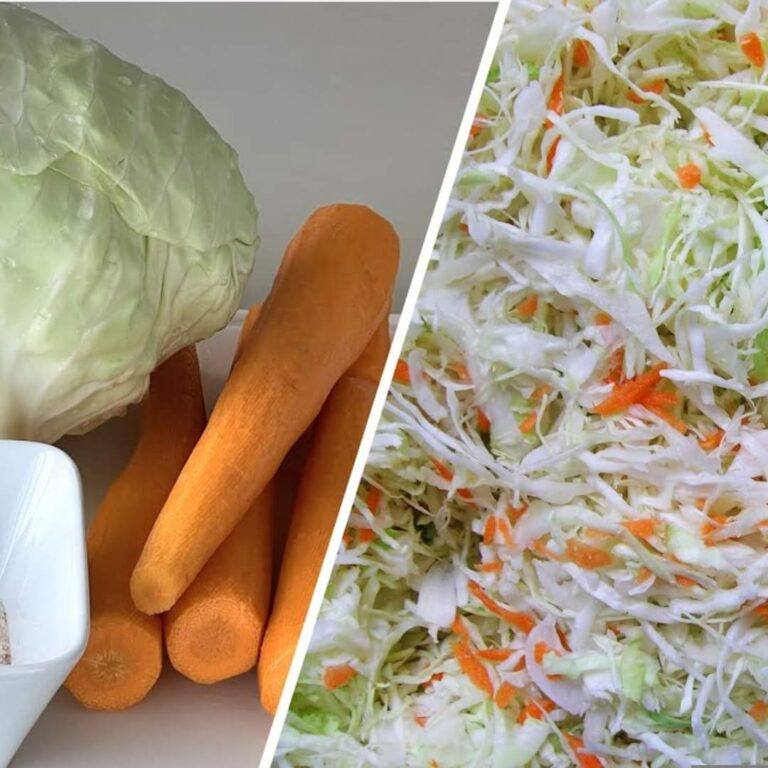ADVERTISEMENT
## Instructions for Making Yummiest Pickled Cabbage
### 1. **Prepare the Cabbage**
Start by **shredding the cabbage**. You can use a sharp knife or a mandoline slicer to get thin, uniform slices. If you prefer, you can also chop it into wedges or chunks, depending on your preference. Once shredded, set the cabbage aside.
### 2. **Make the Pickling Brine**
In a saucepan, combine the **water**, **apple cider vinegar**, **salt**, and **sugar** (if using). Heat the mixture over medium heat, stirring occasionally until the salt and sugar dissolve completely. Once dissolved, remove the saucepan from heat and let the brine cool to room temperature.
### 3. **Pack the Cabbage into Jars**
While the brine is cooling, **prepare the jars**. Sterilize your glass jars by boiling them for a few minutes or washing them in the dishwasher. Then, pack the shredded cabbage tightly into the jars, leaving about 1 inch of space at the top. Add the **garlic**, **mustard seeds**, **dill seeds**, and **dried red chilies** (if using) into the jars, mixing them with the cabbage for added flavor.
### 4. **Pour the Brine Over the Cabbage**
Once the brine has cooled, carefully pour it over the cabbage in the jars, ensuring the cabbage is fully submerged. You can press the cabbage down with a spoon or use a small weight to keep it submerged. If the cabbage isn’t fully submerged, it might not ferment properly.
### 5. **Seal and Store**
Seal the jars with lids, and store them at room temperature for 2-3 days to ferment. The exact time may vary depending on the temperature of your kitchen. During fermentation, the cabbage will become tangy and develop the probiotic benefits that come with fermenting. You’ll notice the flavor change and it will become more vibrant as the days go by.
### 6. **Refrigerate and Enjoy**
After 2-3 days, place the jars in the fridge to slow down the fermentation process. Your pickled cabbage will be ready to enjoy immediately, but the flavors will continue to improve and deepen over time.
## Tips for Perfect Pickled Cabbage
– **Flavor Variations**: Feel free to get creative with the spices and seasonings. Some people like to add **caraway seeds**, **coriander**, **bay leaves**, or even **black peppercorns** for a different flavor profile.
– **Sweetness**: If you prefer a sweeter pickle, increase the sugar slightly or experiment with honey instead of regular sugar.
– **Spicy Pickles**: If you like heat, don’t hold back on the chili peppers! You can also add a pinch of cayenne pepper or use hot mustard seeds.
– **Fermentation Time**: The longer you let the cabbage ferment, the more tangy and sour it will become. Start checking after 2-3 days, and you can leave it for up to a week or more for a stronger flavor.
## Health Benefits of Pickled Cabbage
– **Probiotics**: Fermented foods like pickled cabbage are full of **good bacteria** (probiotics) that promote digestive health, improve gut flora, and boost your immune system.
– **Rich in Nutrients**: Cabbage is a great source of vitamins **C**, **K**, and **B6**, as well as fiber, which aids in digestion and supports overall health.
– **Anti-inflammatory**: The spices used in pickled cabbage, like **garlic** and **mustard seeds**, have natural anti-inflammatory properties that can help reduce inflammation in the body.
– **Detoxing**: The fermentation process also helps cleanse the body and support liver function, making pickled cabbage a great addition to any detox diet.
## How to Use Pickled Cabbage
Pickled cabbage can be used in a variety of ways to elevate your meals:
– **Tacos**: Add a tangy crunch to your tacos with a scoop of pickled cabbage on top.
– **Salads**: Use it as a flavorful topping for salads or in a coleslaw for an added zing.
– **Sandwiches**: Pickled cabbage works wonderfully as a topping for sandwiches, burgers, or wraps, giving them an extra punch of flavor.
– **Snacking**: Enjoy pickled cabbage on its own as a low-calorie, probiotic-rich snack.
## Conclusion
Making your own **pickled cabbage** at home is a simple, affordable way to create a tangy, probiotic-rich food that can be added to a variety of dishes. With its crunchy texture, bold flavor, and numerous health benefits, pickled cabbage is an easy and delicious addition to your kitchen. Whether you’re a seasoned pickler or new to fermenting, this recipe is sure to become a staple in your culinary repertoire!
ADVERTISEMENT
ADVERTISEMENT
